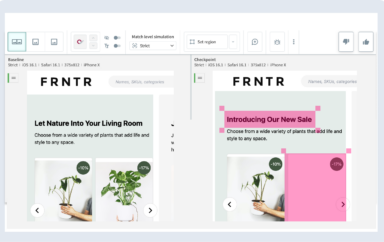We live in a day and age where web traffic and mobile app usage are at an all-time high. Recently, Verizon’s CEO recently reported that “In a week-over-week comparison, streaming demand increased 12%, web traffic climbed 20%, virtual private networks, or VPN, jumped 30% and gaming skyrocketed 75%.”
According to the 2019 State of Automated Visual Testing Report, 400 leading software companies reported that today’s typical “Digitally Transformed” company now boasts 28 unique web and mobile applications, each with 98 pages or screens per app, each in five different screen sizes, and in six different languages. This amounts to about 90,000 page and screen variations accessible every day by customers of a typical company. Visual bugs that are common in such a variety of different screen variations, cost a typical company more than $2m a year in R&D related costs.
One of the most important things to remember is that the visual appearance of a company’s website or mobile app directly reflects on brand recognition. So how can organizations make sure their brand reputation remains impeccable and makes them stay ahead of the competition?

Some say it takes only 50 milliseconds for users to form an opinion about a website or an app. Within this very small amount of time, people determine whether they like your site or not, whether they’ll stay or leave. And, as the saying goes “you get no second chance to make a good first impression.” So you need to make it look perfect on any device, any browser, and any screen size, from the first glance to the last. Any failure to do so can cause your customer to move to your competitor in a heartbeat. For more interesting stats about user experience, see https://www.sweor.com/firstimpressions.
These are the facts that should keep every one of us that has a “Digitally Transformed” business awake at night, looking for a solution as a top priority.
But is there a readily available solution to the above challenge?
The problem is that apps, websites and smart devices have proliferated to the point where any attempt by humans to manage visual and functional quality with the necessary timing and coverage is impossible. The number of screens and page variations is only expected to increase, and the software release cycles are only expected to become faster and faster to support Agile and CI/CD software development life cycles (SDLC).
The only way to cope with this enormous problem in an automated way is by using Artificial Intelligence (AI).
According to Gartner’s Critical Capabilities for Software Test Automation (December 17, 2019), “61% of [its 2019 Software Quality Tools and Practices Survey] respondents said that AI/ML features would be very valuable in software testing tools. Improved defect detection (48%), reduction in test maintenance cost (42%), and improved test coverage (41%) were seen as the top benefits expected from incorporating AI/ML into test automation (multiple answers were allowed).”
Another Gartner research report, Gartner’s Innovation Insight for AI-Augmented Development (May 31, 2019) published by Mark Driver, Van Baker and Thomas Murphy recommends that “application leaders should embrace AI-augmented development now, or risk falling further behind digital leaders.”
In the specific situation I have described, a specific type of AI is needed: Visual AI.
Visual AI is composed of various AI algorithms that mimic the human eye and brain. It can do the work that tens of people would do in weeks, in a matter of minutes, while integrating with the entire app development toolchain and would respond in realtime in the most demanding timing constraints of CI/CD.
As a final note, I would like to say that as the co-Founder and CEO of the company that invented Visual AI and serves more than 400 enterprise customers, many of which are part of the Fortune 500, this kind of technology is quickly becoming top of mind for business and technology leaders. If you’re looking to disrupt your market and beat your competition through innovative software development and delivery practices, you must add Visual AI to your secret sauce, in order to lead your business to prosperity. It was true yesterday and it is many times more important in this challenging time!
Gil Sever is CEO and Co-Founder at Applitools
Cover Photo by Tomas Yates on Unsplash




